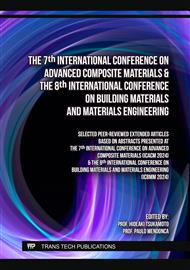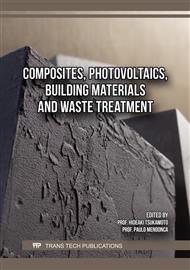[1]
I. Elfaleh, F. Abbassi, M. Habibi, F. Ahmad, M. Guedri, M. Nasri, C. Garnier, A comprehensive review of natural fibers and their composites: an eco-friendly alternative to conventional materials, Results in Engineering (2023) 101271.
DOI: 10.1016/j.rineng.2023.101271
Google Scholar
[2]
M.Y. Khalid, A. Al Rashid, Z.U. Arif, W. Ahmed, H. Arshad, A.A. Zaidi, Natural fiber reinforced composites: Sustainable materials for emerging applications, Results in Engineering 11 (2021) 100263.
DOI: 10.1016/j.rineng.2021.100263
Google Scholar
[3]
F. Vilaplana, S. Karlsson, Quality Concepts for the Improved Use of Recycled Polymeric Materials: A Review, Macro Materials & Eng 293 (2008) 274–297.
DOI: 10.1002/mame.200700393
Google Scholar
[4]
Y. Kumar Yadav, S. Dixit, G. Dixit, A. Namdev, M. Baghel, A. Kumar, Fabrication and mechanical behavior of date palm fibers reinforced high performance polymer composite, Materials Today: Proceedings 82 (2023) 340–345.
DOI: 10.1016/j.matpr.2023.02.147
Google Scholar
[5]
S. Awad, Y. Zhou, E. Katsou, M. Fan, Polymer Matrix Systems Used for Date Palm Composite Reinforcement, in: M. Midani, N. Saba, O.Y. Alothman (Eds.), Date Palm Fiber Composites, Springer Singapore, Singapore, 2020: p.119–159.
DOI: 10.1007/978-981-15-9339-0_4
Google Scholar
[6]
S. Tayde, A. Satdive, B. Toksha, A. Chatterjee, Polyester Resins and Their Use as Matrix Material in Polymer Composites: An Overview, Polyester-Based Biocomposites (2023) 1–23.
DOI: 10.1201/9781003270980-1
Google Scholar
[7]
E. Ligowski, B.C. dos Santos, S.T. Fujiwara, Materiais compósitos a base de fibras da cana-de-açúcar e polímeros reciclados obtidos através da técnica de extrusão, Polímeros 25 (2015) 70–75.
DOI: 10.1590/0104-1428.1605
Google Scholar
[8]
S. Begum, S. Fawzia, M.S.J. Hashmi, Polymer matrix composite with natural and synthetic fibres, Advances in Materials and Processing Technologies 6 (2020) 547–564.
DOI: 10.1080/2374068X.2020.1728645
Google Scholar
[9]
C. Zhang, Y. Li, W. Kang, X. Liu, Q. Wang, Current advances and future perspectives of additive manufacturing for functional polymeric materials and devices, SusMat 1 (2021) 127–147.
DOI: 10.1002/sus2.11
Google Scholar
[10]
G.H. de A. Barbalho, J.J. da S. Nascimento, L.B. da Silva, R.S. Gomez, D.O. de Farias, D.D.S. Diniz, R.S. Santos, M.J. de Figueiredo, A.G.B. de Lima, Bio-polyethylene composites based on sugar cane and Curauá fiber: an experimental study, Polymers 15 (2023) 1369.
DOI: 10.3390/polym15061369
Google Scholar
[11]
D.F. Alvarez Reyes, Characterization of the cashew nut shell as possible source of natural fibers for composite materials applications., (2021).
Google Scholar
[12]
K.C. Córdova-Cisneros, A.O. Castañeda-Facio, A. Sáenz-Galindo, Eco-materiales Compuestos Poliméricos con Aplicaciones en el Área Automotriz, Revista Científica de La Universidad Autónoma de Coahuila 10 (2018).
DOI: 10.17488/rmib.45.2.3
Google Scholar
[13]
M. Ali, A.H. Al-Assaf, M. Salah, Date Palm Fiber-Reinforced Recycled Polymer Composites: Synthesis and Characterization, Advances in Polymer Technology 2022 (2022) 1–10.
DOI: 10.1155/2022/7957456
Google Scholar
[14]
C. Fonseca-Valero, A. Ochoa-Mendoza, J. Arranz-Andrés, C. González-Sánchez, Mechanical recycling and composition effects on the properties and structure of hardwood cellulose-reinforced high density polyethylene eco-composites, Composites Part A: Applied Science and Manufacturing 69 (2015) 94–104.
DOI: 10.1016/j.compositesa.2014.11.009
Google Scholar
[15]
S. Oza, R. Wang, N. Lu, Thermal and mechanical properties of recycled high density polyethylene/hemp fiber composites, International Journal of Applied Science and Technology 1 (2011).
Google Scholar
[16]
S. Mohammed, A. Meghezzi, Y. Meftah, S. Maou, Thermophysical behavior of date palm fiber-reinforced polyvinylchloride/low-density polyethylene/acrylonitrile butadiene rubber copolymer ternary composite, Polyolefins Journal 10 (2023) 225–233.
DOI: 10.17932/ejeas.2021.024/ejeas_v03i2005
Google Scholar
[17]
J. Fajardo, D. Lasso, C. Paltán, L. López, D. Perguachi, L. Cruz, Improving the processing and rheological properties of natural fibre/polypropylene composites, Cuenca, Ecuador: Professor Dept. of Mechanical Engineering, Universidad., 2015.
Google Scholar
[18]
J.I. Fajardo, J. Santos, L. Garzón, L.J. Cruz, Factorial study of process parameters on the orientation state of injected bamboo fibre/polypropylene composite parts, OTTAWA, 2015.
Google Scholar
[19]
J.D. Santos, J.I. Fajardo, A.R. Cuji, J.A. García, L.E. Garzón, L.M. López, Experimental evaluation and simulation of volumetric shrinkage and warpage on polymeric composite reinforced with short natural fibers, Front. Mech. Eng. 10 (2015) 287–293.
DOI: 10.1007/s11465-015-0346-x
Google Scholar
[20]
C.P. Jorge Fajardo, Rheological behavior of bio-based composite: natural fibre/polypropylene., in: Guayaquil - Ecuador, 2019.
Google Scholar
[21]
J.I. Fajardo, C. Paltán, L.M. López, Estimation of injection parameters of a bio-based composite material from the rheological characterization, J. Phys.: Conf. Ser. 1386 (2019) 012037.
DOI: 10.1088/1742-6596/1386/1/012037
Google Scholar
[22]
J.I. Fajardo, M.V. Farez, C.A. Paltán, Experimental analysis of the Relationship between textile structure, tensile strength and comfort in 3D printed structured fabrics, Polymers 15 (2022) 152.
DOI: 10.3390/polym15010152
Google Scholar
[23]
W. Guamán, J.I. Fajardo, C.A. Paltán, Micromechanical Modeling of Biobased Sisal Polylactic Acid Compounds, in: Systems, Smart Technologies and Innovation for Society, Springer Nature Switzerland, Cham, 2024: p.40–49.
DOI: 10.1007/978-3-031-51982-6_4
Google Scholar



